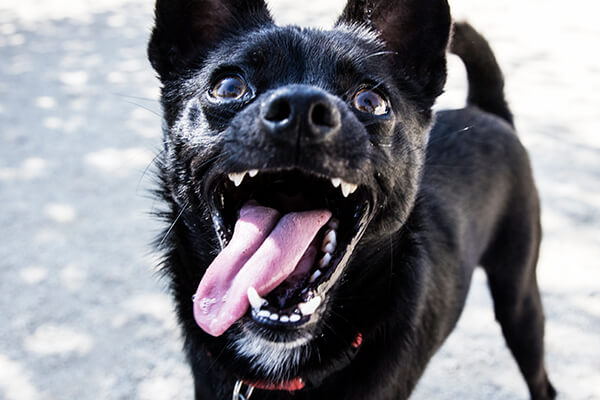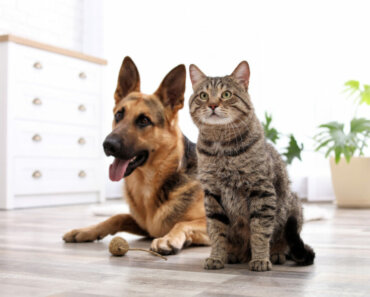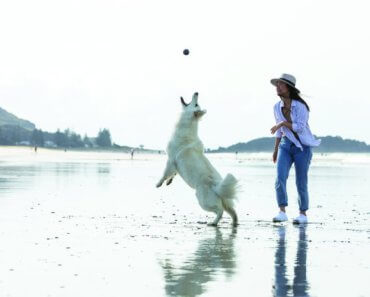Dog zoomies are what they sound like. It’s hard not to smile when you see a joyful dog running wildly around your house or yard, zipping back and forth for a few moments before collapsing after a case of what most of us call the “zoomies.” Dog zoomies, or Frenetic Random Activity Periods (FRAPS) as they’re technically called, generally only last a few minutes at most.

A glint in your dog’s eyes might be a sign that he is about to start zooming. Photography ©amandafoundation.org | E+/Getty Images.
What happens before the dog zoomies hit?
Before the zoomies hit, dogs often get a glint in their eyes, and they may start to play-bow at you or other dogs. Dogs with the zoomies often run quickly from one side of the yard or room to the other, back and forth, or spin in circles until they fall down. My youngest dog really enjoys trying to catch her tail when she has the zoomies. While zoomies in dogs and the frantic movements your dog exhibits when they hit might seem concerning, they are actually a normal part of happy dog behavior, and as long as your dog is zooming in a safe space, these FRAPS are nothing to be concerned about.
Why do zoomies in dogs happen?
Dog zoomies tend to hit puppies and young dogs more frequently than older dogs, but zoomies are a great way for dogs of any age to release pent-up energy. Dogs get the zoomies for a variety of reasons — when they are highly excited or aroused or after watching another dog engage in high-energy play. Sometimes, dogs get the zoomies when they are confused or slightly stressed at a dog-training class, such as when the skills being worked on are challenging and they need to blow off some of that nervous energy.
For many dogs of all ages, bath time brings out the zoomies! Even my 15-year-old dog starts zooming around like a puppy after bath time is over. While dog zoomies are very natural for dogs, if they happen very frequently, it might be a good idea to think about how much exercise your pup gets, and if there are ways to add more structured exercise outlets into his day.
Controlling dog zoomies
Zoomies are a natural part of behavior for dogs, and not something you should worry about preventing or discouraging, so long as your dog is zooming in a safe place. This means inside your home or fenced yard, ideally on carpet, and away from breakable items, or small children or elderly family members who could be accidentally knocked over by a large, zooming dog. Try to avoid letting your dog zoom on hardwood floors, or other slick surfaces. While it might seem funny to see a frapping dog slipping and skidding on floors, it can be very dangerous as your dog could slip and injure himself.
So, instead of trying to control the zoomies in dogs, control the environment in which he zooms. For example, if you know your dog gets the FRAPS after a bath, be sure to take him directly from the bath (either being carried or by leash) to a room or yard where he can safely zoom.
Never chase a dog with the zoomies
Sometimes the dog zoomies will strike your dog not just at a moment that’s inconvenient (like when dinner guests are about to arrive), but at a time or place that’s actually dangerous, like off leash at a dog park that isn’t fenced (please always obey leash laws). In a situation like that, you need to catch your dog quickly, and when a dog has the zoomies he might “forget” his training.
The most important thing, which seems counterintuitive, is not chasing after a frapping dog. If you chase your dog, he is likely to misinterpret this as you playing with him. That will inspire him to continue running! Instead of chasing your dog, run away from him (in a direction free of roads or other dangers) and encourage your dog to follow you in a happy voice. It’s good to be prepared for this moment, and make sure to have high-value treats and/or toys on you at all times.
On a related note, teach your dog that “come” is always a fun idea. To do this, regularly practice recalls with your dog on a longline or in a safely fenced area using treats, praise and other positive techniques to teach your dog to reliably come. Never punish your dog for not coming when called, instead set up training situations that enable him to be successful next time by decreasing distractions, adding a leash or longline, decreasing the distance you are from your dog when you call her, and/or using a higher value treat as a reward.
Dealing with a dog who seems to have a permanent case of the zoomies? Does he have ADHD? What to know about high-energy, hyperactive dogs >>
This piece was originally published on February 13, 2018.
Featured photo: Ksenia Raykova/Getty Images
Read Next: Why Do Dogs Scratch Their Beds?


























